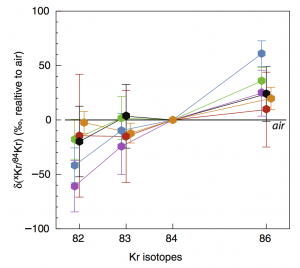Processes of noble gas elemental and isotopic fractionations in plasma-produced organic solids: Cosmochemical implications
M. Kuga, G. Cernogora, Y. Marrocchi, L. Tissandier and B. Marty
November 2017. Geochimica et Cosmochimica Acta, Volume 217, Pages 219-230.
doi: 10.1016/j.gca.2017.08.031
Krypton isotopic composition in delta notation (‰) in the Nebulotron samples (6 samples only where analyzed). Each color represents one sample. Ratios are normalized to 84Kr and to air composition.
Abstract :
The main carrier of primordial heavy noble gases in chondrites is thought to be an organic phase, known as phase Q, whose precise characterization has resisted decades of investigation. The Q noble gas component shows elemental and isotopic fractionation relative to the Solar, in favor of heavy elements and isotopes. These noble gas characteristics were experimentally simulated using a plasma device called the ‘‘Nebulotron”. In this study, we synthesized thirteen solid organic samples by electron-dissociation of CO, in which a noble gas mixture was added. The analysis of their heavy noble gas (Ar, Kr and Xe) contents and isotopic compositions reveals enrichment in the heavy noble gas isotopes and elements relative to the light ones. The isotope fractionation is mass-dependent and is consistent with a mn-type law, where n > 1. Based on a plasma model, we propose that the ambipolar diffusion of ions in the ionized CO gas medium is at the origin of the noble gas isotopic fractionation. In addition, the elemental fractionation of experimental and chondritic samples can be accounted for by the Saha law of plasma equilibrium, which does not depend on the respective noble gas masses but rather on their ionization potentials. Our results suggest that the Q noble gases were trapped into growing organic particles starting from solar gases that were fractionated in an ionized medium by ambipolar diffusion and Saha processes. This would imply that both the formation of chondritic organic matter and the trapping of noble gases took place simultaneously in the ionized areas of the protoplanetary disk.

